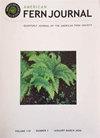There and Back Again: Reticulate Evolution in Ceratopteris
IF 0.9
4区 生物学
Q4 PLANT SCIENCES
引用次数: 6
Abstract
Abstract. Examples of reticulate evolution are known from throughout the tree of life, but are particularly common in ferns due to their unique reproductive biology and few prezygotic reproductive barriers. However, untangling the complex evolution history of these groups can be challenging. Often, several different types of data are needed to understand the full story of reticulate evolution; for example, chloroplast markers trace maternal inheritance, while nuclear markers complete the picture by suggesting paternal inheritance. Next generation sequencing can provide thousands of nuclear loci, which are informative for estimating reticulate evolutionary histories. The model fern genus Ceratopteris is known to have cryptic allotetraploid taxa, and hybridization is common between many species in the genus. To better understand the patterns of hybridization and reticulate evolution in the genus, we constructed a split network analysis using thousands of single nucleotide polymorphisms from samples collected throughout the pan-tropical range of Ceratopteris. Our split network organizes taxa based on genomic similarity, revealing potential introgression between lineages. Combining this analysis with Patterson's D to measure gene flow, as well as contributions by previous authors, we show extensive hybridization and reticulate evolution in Old World Ceratopteris, and also provide evidence for natural hybridization events involving the model species C. richardii.去而复返:角翼龙的网状进化
摘要网状进化的例子在整个生命树中都是已知的,但由于其独特的生殖生物学和很少的受精前生殖障碍,在蕨类植物中尤为常见。然而,解开这些群体复杂的进化史可能具有挑战性。通常,需要几种不同类型的数据来理解网状进化的完整故事;例如,叶绿体标记追踪母体遗传,而核标记则通过暗示父系遗传来完成这幅图。下一代测序可以提供数千个核位点,这些位点为估计网状进化史提供了信息。众所周知,模式蕨类植物Ceratopteris具有隐蔽的异四倍体分类群,该属许多物种之间的杂交很常见。为了更好地了解该属的杂交和网状进化模式,我们使用在整个热带地区采集的数千个单核苷酸多态性构建了一个分裂网络分析。我们的分裂网络根据基因组相似性组织分类群,揭示了谱系之间潜在的渗入。将这一分析与Patterson的D相结合,以测量基因流,以及之前作者的贡献,我们展示了旧世界Ceratopteris的广泛杂交和网状进化,也为涉及模式种C.richardii的自然杂交事件提供了证据。
本文章由计算机程序翻译,如有差异,请以英文原文为准。
求助全文
约1分钟内获得全文
求助全文
来源期刊

American Fern Journal
生物-植物科学
CiteScore
1.20
自引率
0.00%
发文量
28
审稿时长
6 months
期刊介绍:
The American Fern Journal is a peer-reviewed journal focused on the biology of ferns and lycophytes.
 求助内容:
求助内容: 应助结果提醒方式:
应助结果提醒方式:


